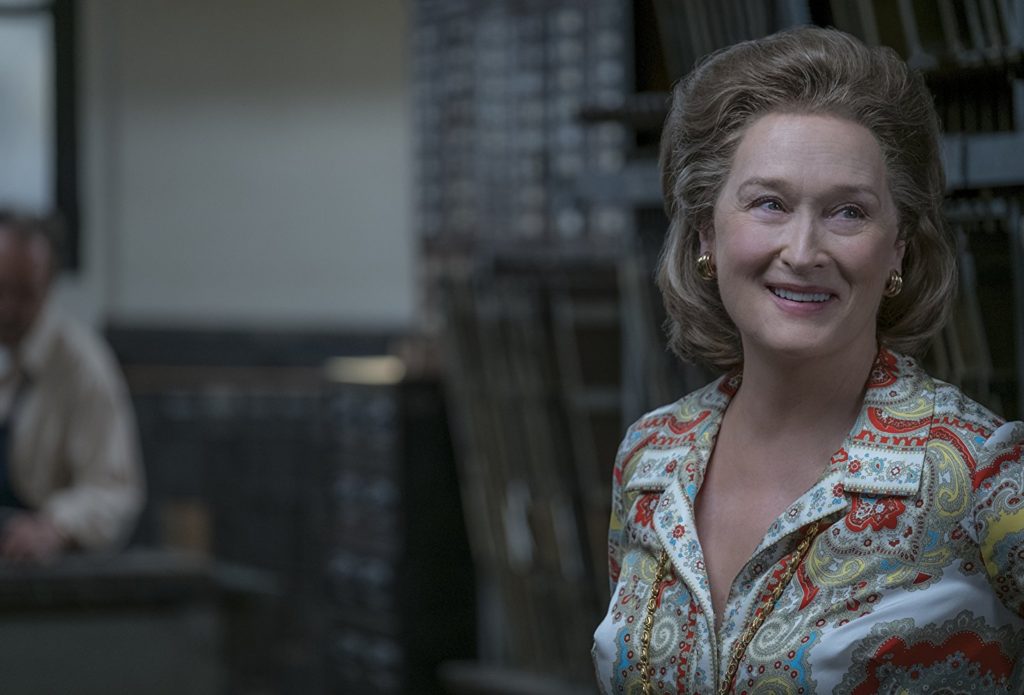
Young journalists can take home lessons from ‘The Post’
By Bradley Wilson
CMR Managing Editor
If there was ever a time for a feel-good movie about the media, it’s now. And in “The Post,” Director Steven Spielberg and big-name stars Meryl Streep and Tom Hanks realize the power and role of the media.
However, the movie goes well beyond showing how a newspaper and a few strong-willed editors and reports can change the course of a country. It brings in a modern discussion of the role of women, limits that need to be placed on government, the need for the First Amendment and even how media outlets also need checks and balances.
For a long-time journalist, it was fascinating to watch molten lead set into words, newsrooms filled with typewriters, copy editors given 30 minutes to work on one story and papers shipped out in hand-tied bundles. It was disheartening to see Katharine Graham portrayed as less than powerful, even weak, leader with shaking hands. She never came across that way when played by Nancy Marchand in the television series Lou Grant. But as her character develops, watching her finally make a decision with such potential negative ramifications and then walking down the steps of the Supreme Court, even in the shadow of The New York Times, was inspirational.
It was also inspirational to watch veteran journalists stand up to the bean counters and lawyers, questioning their own decisions and ultimately deciding to do not necessarily what was easy or what was best for them but for what they thought was in the best interest of the country. The producers make use of actual text from the concurring opinion, “The press was to serve the governed, not the governors.”
Young journalists can take home a lesson taught by Ben Bagdikian and others about how good, investigative, epic journalism often involves months of making copies, ducking out of the office to the back alley to call a source and developing working, professional relationships with potential sources. Background work on a story is more than a Google search.
In short, this is another in a long list of movies that have merit in the media classroom including movies such as Spotlight, Through a Lens Darkly, Absence of Malice, Shattered Glass and All the President’s Men.
Now we just have to wait for Steven Spielberg‘s interpretation of the sequel on Watergate.
PLOT SUMMARY: Katharine Graham, the first female publisher of a major American newspaper – The Washington Post, with help from editor Ben Bradlee, races to catch up with The New York Times to expose a massive cover-up of government secrets that spans three decades and four U.S. presidents. Together, they must overcome their differences as they risk their careers — and freedom — to help bring long-buried truths to light. Rated PG-13 for language and brief war violence
DISCUSSION QUESTIONS
- Meryl Streep plays the country’s first female newspaper publisher Katharine (Kay) Graham during the movie set in 1971. She says it was not a job she wanted. Yet when she walks down the steps of the Supreme Court, clearly she has served as a leader for other women. How might this have been a precursor to the modern #metoo movement? What other references were made in the movie to giving women equal rights, pay and responsibilities? What roles did women play in that world clearly dominated by men?
- At the heart of the movie are the financial challenges being faced by The Washington Post. What challenges? Who owns The Washington Post now? What about the other publications and publishing companies mentioned in the movie: The New York Times, Gannett, Knight Newspapers and Ridder Publications?
- What is a conflict of interest? How did publisher Katharine Graham’s family relationship with Lyndon Johnson, John F. Kennedy and Robert McNamara illustrate a conflict of interest? How did Graham eventually get around it?
- Attorney General John Mitchell cited Section 793 of the Espionage Act as cause to bar further publication of stories. How did the newspapers get access to the top secret documents? Did publication of such documents cause injury to the United States? What was the benefit?
- Even the dissenting opinions given by Chief Justice Warren E. Burger and two others did not argue that there is a need for a free and unfettered press. What did they argue? Burger also said the Times should have discussed the possible repercussions with government officials. In the movie, Editor Ben Bradlee considers this option at the request of corporate attorneys and members of the board of directors. Why doesn’t he discuss the possible publication with government officials? Would you?
- Justice Hugo Black, in his concurring opinion, elaborated on his absolute superiority of the First Amendment.
In the First Amendment, the Founding Fathers gave the free press the protection it must have to fulfill its essential role in our democracy. The press was to serve the governed, not the governors. The Government’s power to censor the press was abolished so that the press would remain forever free to censure the Government. The press was protected so that it could bare the secrets of government and inform the people. Only a free and unrestrained press can effectively expose deception in government.
But the justices did not void the Espionage Act or give the press unlimited freedom to publish classified documents. Other cases prior to 1971 had also dealt with similar issues. Of what significance are these cases?
- Near v. Minnesota, 283 U.S. 697 (1931)
- Dennis. V. United States, 341 U.S. 494 (1951)
- New York Times Co. v. Sullivan, 376 U.S. 254 (1964)
- The movie ends with a security guard reporting a break-in at the Watergate Hotel and the Democratic National Headquarters. This was a reference to what famous historical event culminating in what action by Richard Nixon?
